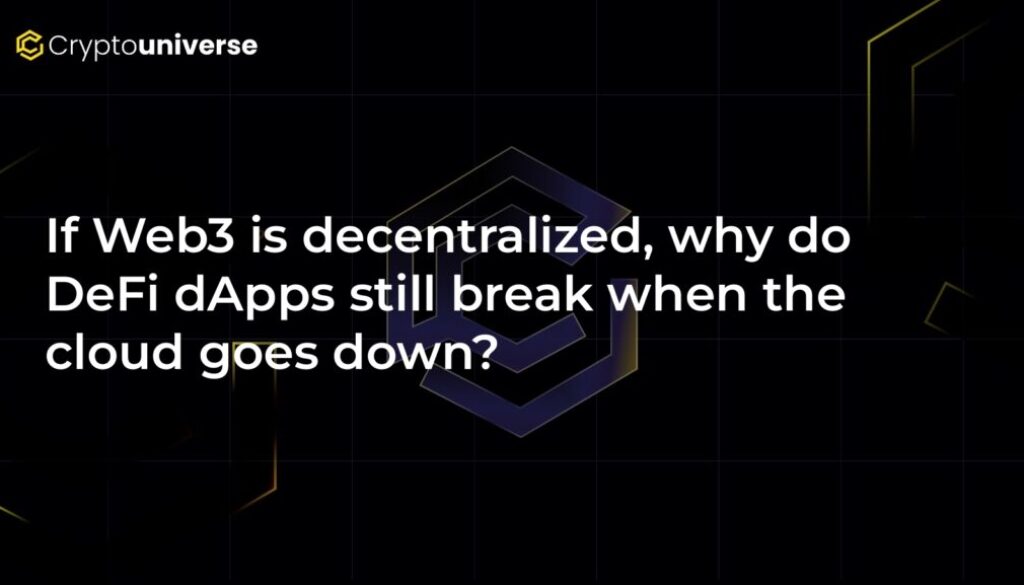If Web3 is decentralized, why do DeFi dApps still break when the cloud goes down?

The Decentralization Paradox: Web3’s Surprising Reliance on Web2 Infrastructure
Web3 was built on the promise of a decentralized internet — a world free from the control of tech giants and single points of failure. Yet, on October 20th, when a single Amazon Web Services (AWS) region experienced a minor hiccup, a significant portion of the crypto world seemed to grind to a halt. Coinbase services degraded, major wallets timed out, and DeFi applications became unresponsive. The incident served as a stark reminder of a quiet but critical truth: for all its decentralized ideals, much of Web3 is still built on the centralized foundations of Web2.
This raises a crucial question for users and builders alike:
The Anatomy of a Modern dApp: A Centralized Stack
While blockchains like Ethereum are incredibly resilient, running on a global network of thousands of nodes, the applications we use to interact with them are not. A typical decentralized application (dApp) relies on a surprisingly centralized stack of services, most of which live in the same data centers as Netflix and Instagram.
Let’s break it down:
- Frontend Hosting: The user interface of most dApps is hosted on centralized services like AWS S3 or Cloudflare Pages. This is the part you see and click on in your browser.
- RPC Gateways: To read data from the blockchain or submit a transaction, dApps need to communicate with a node. Services like Infura, Alchemy, and QuickNode act as intermediaries (RPC providers), but they themselves run their infrastructure primarily on the “Big 3” cloud providers: AWS, Google Cloud, and Azure.
- Indexing and Data: Services like The Graph are needed to quickly query complex blockchain data. These indexers also often rely on centralized cloud hosting.
- Sequencers & Key Management: Layer-2 rollups depend on sequencers to order transactions, and many custody solutions use cloud-based systems. Each of these introduces another potential single point of failure.
When the AWS US-EAST-1 region faltered, it wasn’t the Ethereum consensus that broke. It was the RPC gateways, APIs, and frontends that users depend on. The blockchain was running perfectly fine, but for many, it was completely inaccessible.
The Illusion of Redundancy and Correlated Failure
Many projects believe they have redundancy by using multiple service providers. However, this creates a false sense of security if those providers share the same underlying infrastructure. If two different RPC providers both promise 99.99% uptime but run their nodes in the same AWS region, their failures are not independent. When that AWS region goes down, they both go down together.
This isn’t just a crypto problem. AWS controls nearly a third of the global cloud market. An outage in a major region can impact thousands of companies simultaneously. For crypto, this means a single cloud event can degrade or freeze up to 30% of user-facing applications, completely undermining the promise of unstoppable protocols.
Why This Matters More Than Protocol Uptime
For the average user, the distinction between an on-chain failure (like a blockchain halt) and an off-chain infrastructure failure is irrelevant. A wallet showing a zero balance, a stuck transaction, or an inaccessible DeFi protocol erodes trust all the same. These frequent, off-chain outages damage user confidence far more than rare, on-chain events because they expose a gap between Web3’s marketing and its operational reality.
Regulators are also taking notice. New frameworks are emerging that force financial entities to map out and mitigate their reliance on third-party tech providers:
- The EU’s Digital Operational Resilience Act (DORA), effective in 2025, will require financial firms to report and test their dependencies on cloud providers.
- The UK’s “Critical Third Parties” regime aims to bring major cloud providers under direct regulatory oversight.
As crypto custody and tokenized assets become more integrated with traditional finance, this single-vendor cloud reliance is shifting from a technical challenge to a board-level risk.
The Path to True Resilience: Decentralizing the Full Stack
The good news is that the industry is actively building solutions to address these vulnerabilities. The October outage was a painful but necessary catalyst for change. The focus is now on decentralizing not just the base layer, but the entire application stack.
Here are some of the key innovations underway:
- Provider-Quorum RPCs: Developers are building systems that query multiple RPC endpoints simultaneously (including self-hosted and decentralized options like Pocket Network) and only accept a result if a majority agree, creating resilience against a single provider failure.
- Light Clients: Tools like Helios allow users to verify blockchain data directly from their browser or mobile app, reducing the need to trust a centralized RPC gateway.
- Decentralized Infrastructure: Projects are increasingly using decentralized storage like IPFS and Arweave for frontends and are exploring decentralized sequencers (from projects like Espresso and Astria) for rollups.
- Core Protocol Upgrades: Ethereum’s future roadmap includes proposals like PeerDAS, which aims to make data verification cheap enough to run at the user level, pushing trust to the edges of the network.
Conclusion: From a Brittle Web to a Resilient One
The lesson from recent cloud outages isn’t that Web3 has failed, but that its supporting infrastructure is still catching up to its core principles. True decentralization won’t mean every user runs their own server. It will mean that no single server, company, or data center can bring the system down.
The journey from a centralized application layer to a truly decentralized one is complex, but it’s well underway. Each outage serves as a critical stress test, highlighting weaknesses and accelerating the push toward a more resilient, reliable, and genuinely unstoppable Web3.


